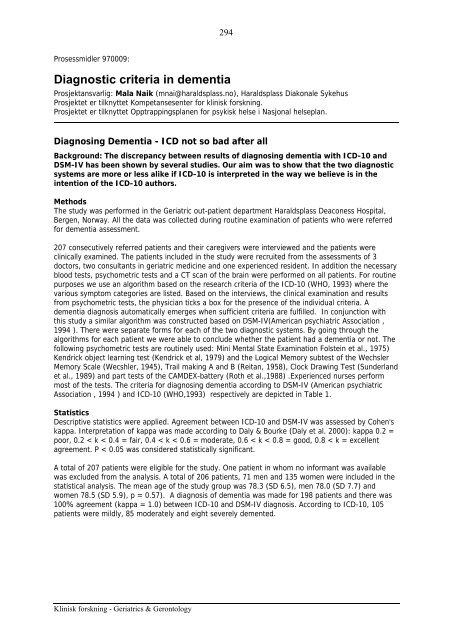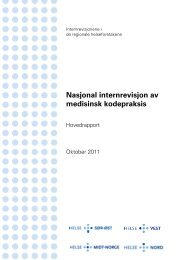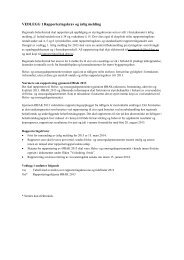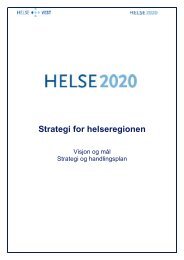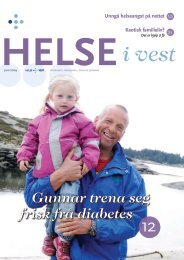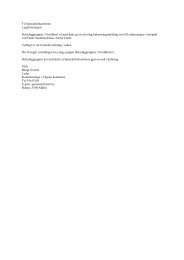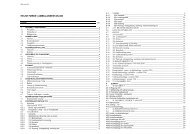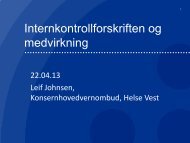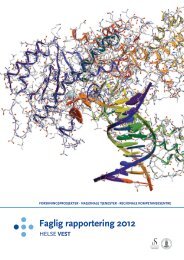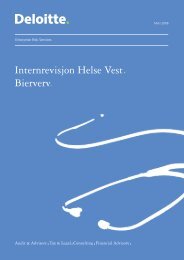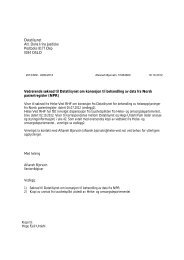- Page 1 and 2:
FORSKNINGSPROSJEKTER - NASJONALE FU
- Page 3 and 4:
2Forord............................
- Page 5 and 6:
4Rolv Terje Lie ...................
- Page 7 and 8:
6TranslasjonsforskningLars A. Aksle
- Page 9 and 10:
8Lerfald S, Thorstensen RCFaglig ra
- Page 11 and 12:
10Hovedinntrykk - forskningsprosjek
- Page 13 and 14:
12Førsteforfattere: Navnene som er
- Page 15 and 16:
14Figur 2: Vitenskapelige publikasj
- Page 17 and 18:
16Tre nasjonale kompetansesentre er
- Page 19 and 20:
18Figur 3: Forskningsprosjekter 200
- Page 21 and 22:
20gjennomsnittstallene i den biblio
- Page 23 and 24:
22Universitetet i Bergen 10,1Unifob
- Page 25 and 26:
24Del 2:Høyspesialiserte tjenester
- Page 27 and 28:
26Leger har undervist for leger i a
- Page 29 and 30:
28Regionalt kompetansesenter RK-HB6
- Page 31 and 32:
30countries."Respir Med. 2006;100 S
- Page 33 and 34:
32Abstrakt fra poster presentert p
- Page 35 and 36:
34Regionalt kompetansesenter RK-HB2
- Page 37 and 38:
36Tidsskr Nor Laegeforen. 2006;126(
- Page 39 and 40:
38Regionalt kompetansesenter RK-HB1
- Page 41 and 42:
406 pågående forskningsprosjekter
- Page 43 and 44:
42søkt å fokusere senterets forsk
- Page 45 and 46:
44ReferansegruppeLars Holst-Larsen
- Page 47 and 48:
46Heier HE, Bugge W, Hjelmeland K,
- Page 49 and 50:
48Forskning:o Mikrosirkulasjon i hu
- Page 51 and 52:
50Nasjonalt kompetansesenter NK-HS1
- Page 53 and 54:
52Ziabreva I, Ballard CG, Aarsland
- Page 55 and 56:
54Nasjonalt kompetansesenter NK-HB1
- Page 57 and 58:
56Bovim E"Evaluating TETRA Applicat
- Page 59 and 60:
58Nasjonalt kompetansesenter NK-HB1
- Page 61 and 62:
60Hallan G, Lie SA, Havelin LI"High
- Page 63 and 64:
62Furnes O"An update from the Norwe
- Page 65 and 66:
64Nasjonalt kompetansesenter NK-HB4
- Page 67 and 68:
66by a sensitive immunoprecipitatio
- Page 69 and 70:
68H.F. Harbo, E. Utsi, Å.R. Lorent
- Page 71 and 72:
70Proteomics and pathology, joint c
- Page 73 and 74:
72Faglige retningslinjerUtredning o
- Page 75 and 76:
74ooooo130 fra Helse Sør139 fra He
- Page 77 and 78:
76Nasjonalt kompetansesenter NK-HB1
- Page 79 and 80:
78Fetveit A, Bjorvatn B"Sleep durat
- Page 81 and 82:
80Tidsskrift for Norsk Psykologfore
- Page 83 and 84:
82ReferansegruppeTrond Sand (trond.
- Page 85 and 86:
842006. Også protokoller for DTI o
- Page 87 and 88:
86Grüner R, Taxt T"Iterative blind
- Page 89 and 90:
88Poster 12th Annual Meeting of the
- Page 91 and 92:
90"Multimodal imaging EEG/fMRI"Pros
- Page 93 and 94:
92Nasjonalt kompetansesenter NK-HB9
- Page 95 and 96:
94Lunding JA, Tefera S, Helge Gilja
- Page 97 and 98:
96Nasjonalt kompetansesenter NK-HB2
- Page 99 and 100:
98Roth K, Hardie JA, Leh F, Andreas
- Page 101 and 102:
100Nasjonalt kompetansesenter NK-HB
- Page 103 and 104:
102"The Estimation and Application
- Page 105 and 106:
104• Prosjekter innenfor septikem
- Page 107 and 108:
106Nasjonalt kompetansesenter NK-HB
- Page 109 and 110:
1084 pågående forskningsprosjekte
- Page 111 and 112:
110Livskvalitetsstudier etter brann
- Page 113 and 114:
112Landsfunksjon L-HB3:Behandling m
- Page 115 and 116:
114Forskningsproduksjon1 vitenskape
- Page 117 and 118:
116Forskning:Fra materialet i Svang
- Page 119 and 120:
118Flerregional funksjon F-HB1:Coch
- Page 121 and 122:
120Nøkkeltall 2006• 0,3 årsverk
- Page 123 and 124:
122Undervisning av pasienter og på
- Page 125 and 126:
124Endringer i aktivitet i forhold
- Page 127 and 128:
126Flerregional funksjon F-HB7:Stan
- Page 129 and 130:
128Forskerutdanning - dr.grad 91117
- Page 131 and 132:
130Forskerutdanning - dr.grad 91117
- Page 133 and 134:
132Nasjonalt kvalitetsregister 9111
- Page 135 and 136:
134Forskerutdanning - dr.grad 91108
- Page 137 and 138:
1361 forskningspublikasjoner i 2006
- Page 139 and 140:
1382 forskningspublikasjoner i 2006
- Page 141 and 142:
140"Dietary predictors of plasma to
- Page 143 and 144:
142Forskerutdanning - dr.grad 91115
- Page 145 and 146:
144Forskerutdanning - dr.grad 91108
- Page 147 and 148:
146Am Heart J. 2006;152(5):888-95PM
- Page 149 and 150:
148Arch Intern Med. 2006;166(1):88-
- Page 151 and 152:
150J Nutr. 2006;136(6 Suppl):1731S-
- Page 153 and 154:
152Forskerutdanning - dr.grad 91106
- Page 155 and 156:
154Forskningsprosjekt 911216:Synshe
- Page 157 and 158:
156Forskningsprosjekt 911113:Regist
- Page 159 and 160:
158Forskningsprosjekt 911025:Barn i
- Page 161 and 162:
16010 vitenskapelige artikler er pu
- Page 163 and 164:
162Korttidsprosjekt 911291:Svangers
- Page 165 and 166:
164Forskerutdanning - dr.grad 91125
- Page 167 and 168:
166Utenlandsstipend 911280:Folkesyk
- Page 169 and 170:
168Forskningsprosjekt 911220:Use of
- Page 171 and 172:
170Referanseliste• Bredrup, C. et
- Page 173 and 174:
172Forskningsprosjekt 911122:Adipoc
- Page 175 and 176:
174Forskningsprosjekt 911207:Tuberc
- Page 177 and 178:
176Forskningsprosjekt 911221:Role o
- Page 179 and 180:
178Strategiske midler - forskningsp
- Page 181 and 182:
180Forskerutdanning - postdoc 91127
- Page 183 and 184:
182finn nokon primær årsak til pr
- Page 185 and 186:
184Forskningsprosjekt 911100:Cytoki
- Page 187 and 188:
186Korttidsprosjekt 911288:In vivo
- Page 189 and 190:
188Forskningsprosjekt 911121:Intrak
- Page 191 and 192:
190Forskningsprosjekt 911111:Geneti
- Page 193 and 194:
192Forskerutdanning - postdoc 91127
- Page 195 and 196:
194Forskerutdanning - dr.grad 91123
- Page 197 and 198:
196Forskerutdanning - postdoc 91127
- Page 199 and 200:
198Poster presented at the 4th Symp
- Page 201 and 202:
2001 forskningsbiobanker er tilknyt
- Page 203 and 204:
202Strategiske midler - spesielle s
- Page 205 and 206:
2042 forskningspublikasjoner i 2006
- Page 207 and 208:
206• Regionsjukehus 13,9%Diagnosa
- Page 209 and 210:
208Forskerutdanning - dr.grad 91126
- Page 211 and 212:
210Forskningsprosjekt 911209:Selvmo
- Page 213 and 214:
212PMID: 16600013Johansson I, Holm
- Page 215 and 216:
214Heier HE, Bugge W, Hjelmeland K,
- Page 217 and 218:
216Relaterte publikasjonar1. Florez
- Page 219 and 220:
218Forskerutdanning - dr.grad 91116
- Page 221 and 222:
220Lipids Health Dis. 2006;5:6PMID:
- Page 223 and 224:
222Forskningsprosjekt 911306:Chroni
- Page 225 and 226:
224Strategiske midler - forprosjekt
- Page 227 and 228:
226Forskningsprosjekt 911301:Rasjon
- Page 229 and 230:
228Forskningsprosjekt 911112:Tverrf
- Page 231 and 232:
230Forskningsprosjekt 911305:Vaksin
- Page 233 and 234:
232For barn i alderen 4-15 år:•
- Page 235 and 236:
234Forskningsprosjekt 911125:Gene a
- Page 237 and 238:
236Forskerutdanning - dr.grad 91126
- Page 239 and 240:
238Forskerutdanning - dr.grad 91126
- Page 241 and 242:
240Forskerutdanning - dr.grad 91115
- Page 243 and 244: 242Forskerutdanning - dr.grad 91108
- Page 245 and 246: 244Forskerutdanning - postdoc 91127
- Page 247 and 248: 246Forskerutdanning - dr.grad 91106
- Page 249 and 250: 248Forskerutdanning - dr.grad 91106
- Page 251 and 252: 250Forskningsprosjekt 911300:Medfø
- Page 253 and 254: 252Forskningsprosjekt 911024:Charnl
- Page 255 and 256: 254Forskerutdanning - dr.grad 91116
- Page 257 and 258: 256Forskerutdanning - dr.grad 91126
- Page 259 and 260: 258Strategiske midler - belønning
- Page 261 and 262: 260Forskerutdanning - dr.grad 91106
- Page 263 and 264: 262Forskerutdanning - dr.grad 91125
- Page 265 and 266: 264Strategiske midler - forskningsp
- Page 267 and 268: 2661 vitenskapelige artikler er pub
- Page 269 and 270: 268J Neurol Neurosurg Psychiatry. 2
- Page 271 and 272: 270Prosessmidler 970002:Pexy vs. No
- Page 273 and 274: 272"2006 Abstract:The importance of
- Page 275 and 276: 274Strategiske midler 911313:Region
- Page 277 and 278: 276J Perinat Med. 2006;34(5):367-70
- Page 279 and 280: 278Forskerutdanning - dr.grad 91000
- Page 281 and 282: 280Strategiske midler - forprosjekt
- Page 283 and 284: 282"Application of genotyping durin
- Page 285 and 286: 284Forskningsprosjekt 911106:Non-in
- Page 287 and 288: 286Forskerutdanning - dr.grad 91125
- Page 289 and 290: 288Forskningsprosjekt 911190:Magnet
- Page 291 and 292: 290av forsøkspersonene rapporterer
- Page 293: 292Forskningsprosjekt 911217:Cancer
- Page 297 and 298: 296Forskerutdanning - dr.grad 91117
- Page 299 and 300: 298Forskningsprosjekt 911028:Preven
- Page 301 and 302: 300Forskningsprosjekt 911102:Utvikl
- Page 303 and 304: 302Forskerutdanning - dr.grad 91116
- Page 305 and 306: 304with tenecteplase."J Thromb Thro
- Page 307 and 308: 306Korttidsstipend 911293:Diagnosti
- Page 309 and 310: 308Forskerutdanning - dr.grad 91115
- Page 311 and 312: 310Gold, C., Lygren, M., Karterud,
- Page 313 and 314: 312I de nedre luftveier synes likev
- Page 315 and 316: 314Prosessmidler 970001:Stenoser i
- Page 317 and 318: 316Korttidsprosjekt 911287:Skin exp
- Page 319 and 320: 318Prosessmidler 970010:Insidens, m
- Page 321 and 322: 320Hva kjennetegner barn med fedme?
- Page 323 and 324: 322Forskerutdanning - dr.grad 91115
- Page 325 and 326: 3247 forskningspublikasjoner i 2006
- Page 327 and 328: 326Prosessmidler 970003:Helserelate
- Page 329 and 330: 328Forskerutdanning - postdoc 91118
- Page 331 and 332: 330Forskerutdanning - dr.grad 91107
- Page 333 and 334: 332Forskningsprosjekt 911228:Magnet
- Page 335 and 336: 334Forskerutdanning - dr.grad 91116
- Page 337 and 338: 336Forskerutdanning - dr.grad 91126
- Page 339 and 340: 338Cancer Res. 2006;66(6):3303-9PMI
- Page 341 and 342: 340Forskerutdanning - dr.grad 91125
- Page 343 and 344: 342Forskerutdanning - postdoc 91127
- Page 345 and 346:
344Korttidsstipend 911282:Tumorbiol
- Page 347 and 348:
346Forskningsprosjekt 911224:Psykof
- Page 349 and 350:
348Forskerutdanning - dr.grad 91108
- Page 351 and 352:
350Forskningsprosjekt 911099:Eksper
- Page 353 and 354:
352Forskningsprosjekt 911109:Multip
- Page 355 and 356:
354Forskerutdanning - dr.grad 91108
- Page 357 and 358:
356Forskningsprosjekt 911296:Funksj
- Page 359 and 360:
35843 vitenskapelige artikler er pu
- Page 361 and 362:
360"Flt3 Y591 duplication and Bcl-2
- Page 363 and 364:
362ID: 1372 (FHI Biobankregisteret)
- Page 365 and 366:
364melanom i øyet. I arbeidet har
- Page 367 and 368:
3665 vitenskapelige artikler er pub
- Page 369 and 370:
368cell death."Curr Pharm Biotechno
- Page 371 and 372:
370show a broad cytokine release pr
- Page 373 and 374:
372Forskerutdanning - dr.grad 91107
- Page 375 and 376:
374Forskerutdanning - dr.grad 91106
- Page 377 and 378:
376Utenlandsstipend 911277:Nye tekn
- Page 379 and 380:
378PMID: 17105820Karrman K, Foresti
- Page 381 and 382:
380epilepsy due to hippocampal scle
- Page 383 and 384:
382Løberg EM, Jørgensen HA, Green
- Page 385 and 386:
3842 vitenskapelige artikler er pub
- Page 387 and 388:
386Strategiske midler - belønning
- Page 389 and 390:
388Korttidsprosjekt 911295:Clinical
- Page 391 and 392:
390Forskningsprosjekt 911105:ADHD i
- Page 393 and 394:
39220th Norwegian Research Council
- Page 395 and 396:
394Centola M, Frank MB, Bolstad AI,
- Page 397 and 398:
3964 vitenskapelige artikler er pub
- Page 399 and 400:
398Staalesen V, Knappskog S, Chrisa
- Page 401 and 402:
400Forskerutdanning - postdoc 91118
- Page 403 and 404:
402Forskerutdanning - dr.grad 91116
- Page 405 and 406:
404Forskerutdanning - dr.grad 91107
- Page 407 and 408:
406Forskningsprosjekt 911298:Therap
- Page 409 and 410:
408Forskerutdanning - postdoc 91118
- Page 411 and 412:
410Forskningsprosjekt 911042:Steroi
- Page 413 and 414:
4123 forskningspublikasjoner i 2006
- Page 415 and 416:
4141 vitenskapelige artikler er pub
- Page 417 and 418:
416"Switching from insulin to oral
- Page 419 and 420:
4189 vitenskapelige artikler er pub
- Page 421 and 422:
420Strategiske midler - belønning
- Page 423 and 424:
422Forskningsprosjekt 911225:Differ
- Page 425 and 426:
424Forskerutdanning - dr.grad 91126
- Page 427 and 428:
426Forskningsprosjekt 911211:MR nyr
- Page 429 and 430:
428Forskerutdanning - dr.grad 91125
- Page 431 and 432:
4307 vitenskapelige artikler er pub
- Page 433 and 434:
432Forskerutdanning - postdoc 91126
- Page 435 and 436:
434Forskerutdanning - dr.grad 91118
- Page 437 and 438:
436Forskerutdanning - dr.grad 91116
- Page 439 and 440:
438Exp Cell Res. 2006;312(6):782-95
- Page 441 and 442:
440Storstein A, Krossnes B, Vedeler
- Page 443 and 444:
442Tzoulis C, Engelsen BA, Telstad
- Page 445 and 446:
444Monstad SE, Storstein A, Dørum
- Page 447 and 448:
446Forskerutdanning - dr.grad 91117
- Page 449 and 450:
448Forskningsprosjekt 911219:Preven
- Page 451 and 452:
450Aftenposten 22 august 2006Interv
- Page 453 and 454:
452Tematisk oversikt over forskning
- Page 455 and 456:
454Molnes, Janne: Glucokinase - the
- Page 457 and 458:
456Langeland, Nina: Klinisk infeksj
- Page 459 and 460:
458Lund-Johansen, Morten: Kliniske
- Page 461 and 462:
460Norman, Elisabeth: Intuition and
- Page 463 and 464:
462Vågnes, Øyvind Brune: G-protei
- Page 465 and 466:
464ForskningsbiobankerDet nasjonale
- Page 467 and 468:
466FHI ID: 84"Biobank for Nasjonalt
- Page 469 and 470:
468FHI ID: 1146"Biobank ved klinisk
- Page 471 and 472:
470Avlagte doktorgrader 2006Kandida
- Page 473 and 474:
472Prosjektnr: 9399-911264 (NSD / H
- Page 475 and 476:
474Manglende rapporteringNoen prosj
- Page 477:
ISBN 978-82-8045-015-9


